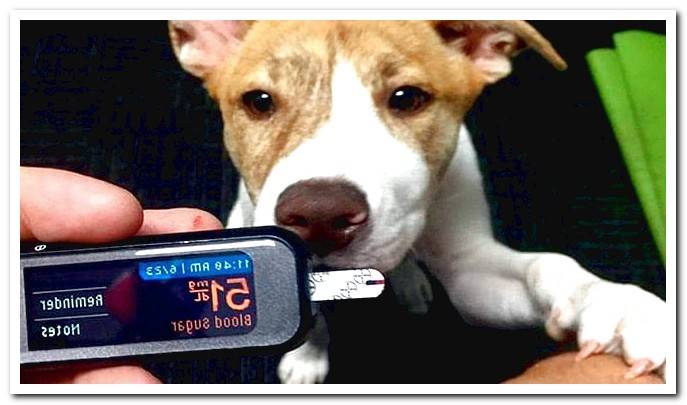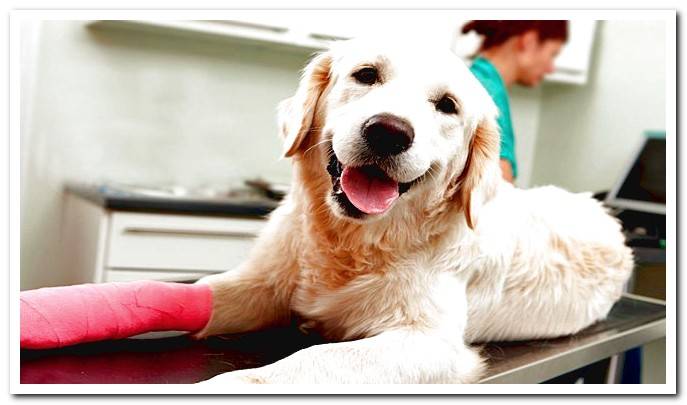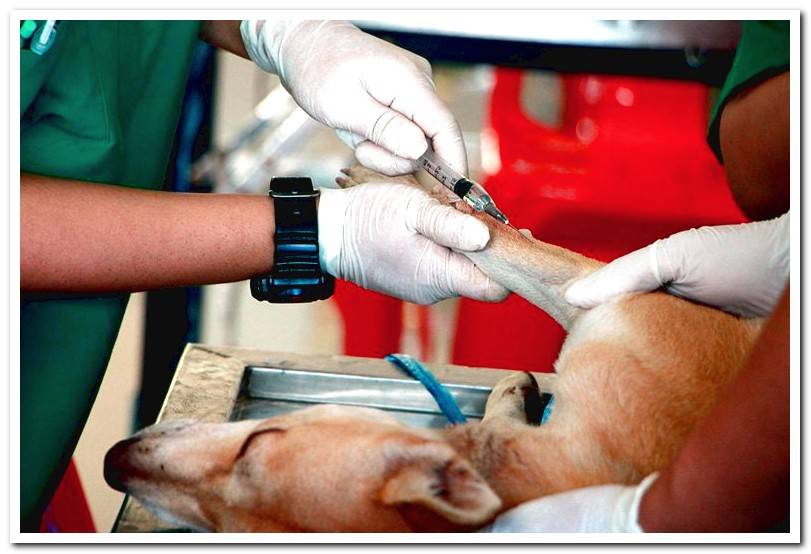
Just like humans, dogs can also have both type 1 and type 2 diabetes mellitus. This disease is characterized by elevated blood glucose levels.
Next we will detail what symptoms should make us suspect that our dog has this pathology. It is very important that we seek veterinary assistance to balance glucose and avoid complications from its increase.
Index of contents
- 1 What is the diabetes?
- 2 Which dogs can suffer from diabetes?
- 3 Diabetes symptoms in dogs
- 4 What is diabetic ketoacidosis?
- 5 How is diabetes diagnosed in dogs?
- 6 Diabetes Treatment in Dogs
- 7 Insulin administration precautions
- 8 Diet and diabetes
- 8.1 Obesity in diabetic dogs
- 8.2 Slim diabetic dogs
- 9 What is the relationship between sterilization and diabetes?
- 10 Diabetes prognosis in dogs
What is the diabetes?
Diabetes is a common disease in dogs. It can be type 1 or type 2. It is caused by an inadequate secretion of insulin, which is a hormone that is produced in cells of the pancreas and whose function is to regulate glucose levels in the blood.
The destruction of these cells may follow a pancreatitis, which is inflammation of the pancreas. Insulin works by helping glucose enter cells throughout the body, where it undergoes different processes to produce the energy necessary for the body to function.
When there is not enough insulin, the glucose level rises above the normal range. It is what is called hyperglycemia. The opposite is hypoglycemia, a situation that can also occur and that implies that the glucose level is lower than normal.
Which dogs can suffer from diabetes?
This disease can affect any dog, but a higher incidence has been found in some breeds such as the Golden retriever or the Poodle. There seems to be a genetic predisposition. In addition, it affects females to a greater extent. The age of onset is between six and nine years.

Diabetes symptoms in dogs
Among the different symptoms that we can appreciate in the face of what is colloquially known as a rise or fall of sugar, the following should be highlighted:
- Glucosuria, which is the presence of a large amount of glucose in the urine.
- Due to glycosuria, the dog urinates in large quantities.
- By urinating so much, fluid loss is compensated for by increased water intake.
- Abundant excretion of urine can lead to dehydration of the dog.
- Increased appetite at first because the dog cannot metabolize enough glucose. Subsequently, this is lost to the extent that the animal is suffering from malnutrition.
- Weight loss.
- When the disease is advanced, it can affect all organs and produce symptoms such as lethargy, vomiting, weakness and, in the most severe cases, coma.
- Associated complications include cataracts, renal problems and neurological, urinary tract infections or high blood pressure.
What is diabetic ketoacidosis?
It is a disorder that arises as a consequence of severe hyperglycemia. Produces the accumulation of ketones in the blood. Ketones are products of fat metabolism. In ketoacidosis, the body does not have glucose to obtain energy, so it turns to fats.
Its symptoms are generalized weakness, vomiting, rapid breathing, and the smell of acetone on the breath. Is about an emergency with risk of death. The dog must be transferred to the veterinary center immediately.

How is diabetes diagnosed in dogs?
To confirm that the clinical signs correspond to this disease, the veterinaryn must take a blood and urine sample. They will show glucose elevated above the normal range. Fructosamine is another important parameter to monitor for the diagnosis and monitoring of diabetes.
Diabetes Treatment in Dogs
Treatment focuses on two basic pillars, which are food and medication. The dog will need to be injected with insulin daily to make up for what his body cannot produce. If we are rigorous with the treatment, the dog will be able to lead a normal life, although it is true that its life expectancy may be reduced.
Veterinary control must be exhaustive because each dog you will need a different amount of insulin and even the doses will vary throughout the life of the same dog. Therefore, at the beginning of the treatment, the veterinaryn will have to monitor the glucose levels in order to see when the maximum and minimum levels occur.
With all the information, adjust the dose and decide when to give the injections. As we will have to prick the dog at home, the vet will explain how to do it. If we are afraid, we can put the first injection in the clinic itself, with the support of the veterinaryn, so that we can resolve any doubts.
Insulin administration precautions
The consequences of inadequate insulin administration can be serious, so it is essential that we strictly follow the veterinaryn’s instructions regarding the amount and type of insulin, its storage, the frequency of administration or the type of syringes.
If we go over the dose, glucose can drop to alarming levels. This hypoglycemia causes confusion, sleep, tremors, wobbles, seizures, and even coma.

Diet and diabetes
It is recommended that a diabetic dog consume a dry or wet diet with a high fiber content, hypocaloric and with complex carbohydrates, because they are the ones that reduce the possibility of hyperglycemia being triggered. This is because they minimize glucose fluctuations after each intake.
For sale in veterinary clinics we will find this type of food in different presentations. If we prefer one homemade diet We must develop a menu with the vet. In any case, the food should be administered in two or three daily doses to avoid hyperglycemia after heavy intake.
Finally, the insulin dose is calculated based on the daily calorie requirements, which depend on the dog’s weight and the activity it develops. So it is important that we do not vary th
e amount of food that we offer each day. In addition, the dog must exercise daily, as it increases the absorption of insulin.
Obesity in diabetic dogs
In addition to a diet adapted to the dog’s disease, it is essential that we avoid being overweight. Obesity negatively affects health, complicates diseases, predisposes others or makes it difficult to administer anesthesia. In the case of diabetes, it reduces the response to insulin, making it difficult to control.
So if the dog is too fat, in addition to diabetes treatment, the vet will determine his ideal weight and prescribe a suitable diet to achieve this. Specific feeds for these disorders are currently available.
Slim diabetic dogs
If the dog has already lost weight by the time diabetes is diagnosed, it is important that he return to his ideal weight. To achieve this, low fiber diets are recommended because they contain a higher caloric density. We can also find them for sale.
What is the relationship between sterilization and diabetes?
As part of diabetes treatment the vet can recommend the sterilization in the case of females, that is, the removal of the uterus and ovaries. This is because progesterone has a hyperglycemic effect.
Diabetes prognosis in dogs
The prognosis of this pathology will depend on each case. In addition, factors such as the owner’s ability to follow the prescribed treatment, the ease or not of controlling glucose levels and the presence or absence of other diseases influence.
In specific cases diabetes can remit, for example, in bitches with pyometra or ovarian remainder. Also, as in the case of women, when diabetes is due to a pregnancy.
